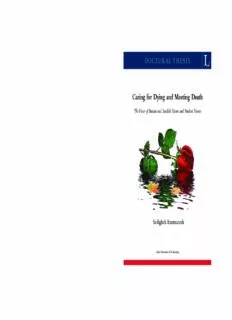
Caring for dying and meeting death PDF
Preview Caring for dying and meeting death
ISSN: 1402-1544 ISBN 978-91-86233-XX-X Se i listan och fyll i siffror där kryssen är DOCTORA L T H E S IS S e d ig h e Department of Health Science h Division of Nursing Ira Caring for Dying and Meeting Death n m a n e s ISSN: 1402-1544 ISBN 978-91-86233-01-3 h The Views of Iranian and Swedish Nurses and Student Nurses C Luleå University of Technology 2009 a r in g fo r D y in g a n d M e e t in g D e a t h T h e V ie w s o f I ra n ia n a n d S w e d ish N Sedigheh Iranmanesh u rse s a n d S tu d e n t N u rses Luleå University of Technology Caring for Dying and Meeting Death The Views of Iranian and Swedish Nurses and Student Nurses Sedigheh Iranmanesh Department of Health Science Division of Nursing Luleå University of Technology Sweden i Tryck: Universitetstryckeriet, Luleå ISSN: 1402-1544 ISBN 978-91-86233-01-3 Luleå (cid:17)(cid:15)(cid:15)(cid:24) (cid:76)(cid:76)(cid:76)(cid:13)(cid:65)(cid:73)(cid:74)(cid:13)(cid:72)(cid:58) ii To my family and all nurses working with dying persons iii iv It is sad that our society hides from the reality of death, the natural law of nature, and in doing so diminishes the opportunity to learn, to share the experience in an atmosphere of unconditional love; the opportunity that, so many times, only emerge as the final bell in life is about to be rung. Albom, Mitch. Tuesdays with Morrie. London: Time Warner Paperback, 2003 v vi Abstract Nurses play a principal role in the caring for dying persons and their families. Increasing diversity and globalisation demand culturally sensitive and competent health personnel who have scientifically based knowledge about the universal phenomenon of death and dying. A mixed method of research was conducted to describe student nurses’ and nurses’ views of caring for dying people in the cultural contexts of Iran and Sweden. In the first part, a quantitative method with two questionnaires (FATCOD and DAP-R) was used to examine the student nurses’ and registered nurses’ attitudes towards death and caring for dying persons in Iran. In the second part, a phenomenological hermeneutic approach was used to illuminate the meaning of nurses’ experiences with the caring for dying persons in the cultural contexts of Iran and Sweden. According to the results (I, II), student nurses’ and nurses’ attitudes towards caring for dying people were influenced by their attitudes towards death, education, previous experience with death, and previous experience of caring for a dying relative. Iranian nurses were unlikely to talk about death with dying persons and their families. The findings of the qualitative part indicate that professional care for dying people is a lifelong learning process that takes place in a socio- cultural context (III, IV). The Iranian and Swedish registered nurses’ experiences showed similarities that crossed cultures. The existential context for their care was almost identical. The nurses met people and their families at the end of their lives. Being invited to share the understanding of this unique experience raised an ethical demand to care within close relationships. It called for a personal and professional response in all aspects. Swedish nurses preserved patients’ dignity by meeting personal caring needs according to each person’s preferences as well as providing each person with appropriate information. Iranian nurses were also concerned about each person’s dignity, although they were not allowed to inform persons and family members about a person’s real condition. They believed that such information could hasten the patient’s death. Swedish nurses regularly used teamwork. Team reflective practices were important in the support of their professional development. The study revealed that Iranian nurses lacked collaboration between nurses and other professionals, including social workers. The results suggest that student nurses and nurses should be offered the opportunity to reflect on their experiences, feelings, actions, and reactions to death, as well as caring for dying people and their families. This could be accomplished at work or in professionally guided individual or group sessions. Such supervision could transform their personal experiences into positive and constructive learning. Recognition of the common foundation behind different cultures, religions, and nurses’ own caring behaviours could support the universal phenomenon of care as a human mode of being, in order to be able to provide culturally sensitive and competent and supportive care to patients with various cultural backgrounds. General educational programmes and programmes dealing with end of life care must focus on to the fact that patients’ and family members are unique beings with unique backgrounds and preferences. Specific training programmes should aim at increasing an understanding among professional carers about what shape patients’ world views in order to support their dignity and well-being at the end of life. Keywords: Attitude towards death, Attitude towards caring for dying people, Caring for dying people, Lived experience, Transcultural study, Iranian registered nurses, Swedish registered nurses, Student nurses. vii viii
Description: